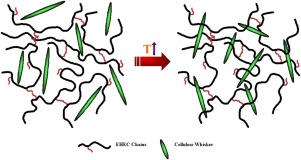当前位置:
X-MOL 学术
›
Colloids Surf. A Physicochem. Eng. Aspects
›
论文详情
Our official English website, www.x-mol.net, welcomes your
feedback! (Note: you will need to create a separate account there.)
Tunable viscoelastic features of aqueous mixtures of thermosensitive ethyl(hydroxyethyl)cellulose and cellulose nanowhiskers
Colloids and Surfaces A: Physicochemical and Engineering Aspects ( IF 4.9 ) Pub Date : 2020-04-01 , DOI: 10.1016/j.colsurfa.2020.124489 Erfan Dashtimoghadam , Hamed Salimi-Kenari , Rasool Nasseri , Kenneth D. Knudsen , Hamid Mirzadeh , Bo Nyström
Colloids and Surfaces A: Physicochemical and Engineering Aspects ( IF 4.9 ) Pub Date : 2020-04-01 , DOI: 10.1016/j.colsurfa.2020.124489 Erfan Dashtimoghadam , Hamed Salimi-Kenari , Rasool Nasseri , Kenneth D. Knudsen , Hamid Mirzadeh , Bo Nyström

|
Abstract Ethyl(hydroxyethyl) cellulose (EHEC) is known to form reversible hydrogels in water at elevated temperatures in the presence of an ionic surfactant. However, the toxicity of common ionic surfactants (like SDS and CTAB) hampers pharmaceutical and biomedical applications of EHEC-based thermogels. Addition of a nature-based material to EHEC solutions - in the form of negatively charged cellulose nanowhiskers (CNWs) - will introduce an internal electrostatic repulsion that could also produce the balanced swelling necessary for forming a stable gel at elevated temperatures (ca. 37 °C). This may therefore be an alternative way of designing low toxicity thermoresponsive hydrogels of high mechanical strength for pharmaceutical and biomedical applications without the use of ionic surfactants. The properties of the temperature-induced gelling systems (EHEC/CNW and EHEC/SDS/CNW) were characterized by rheological methods and rheo-small angle light scattering (rheo-SALS), whereas the structure and morphology of CNWs were examined by transmission electron microscope (TEM) and small angle neutron scattering (SANS). Oscillatory shear results for the EHEC/CNW system showed that the gel temperature (ca. 37 °C) was virtually unaffected by the amount of added CNWs, while the fractal dimension values (2.2–2.3) suggested the evolution of a tighter incipient gel network with increasing level of added CNWs. Furthermore, a threefold increase of the gel strength parameter was observed with increasing concentration of CNWs. For the EHEC/CNW/SDS system, a more open network evolved with increasing amount of CNWs, and for this system, higher values of the gel strength parameter were found. Pronounced shear-thinning, even at very low shear rates, was observed for the EHEC/CNW system at all levels of CNW addition, whereas for the EHEC/CNW/SDS system, Newtonian-like behavior was detected at low shear rates.
中文翻译:

热敏乙基(羟乙基)纤维素和纤维素纳米晶须的水性混合物的可调粘弹性特征
摘要 已知乙基(羟乙基)纤维素 (EHEC) 在离子表面活性剂的存在下,在升高的温度下在水中形成可逆水凝胶。然而,常见离子表面活性剂(如 SDS 和 CTAB)的毒性阻碍了基于 EHEC 的热凝胶的制药和生物医学应用。在 EHEC 溶液中添加一种基于自然的材料——以带负电的纤维素纳米晶须 (CNW) 的形式——将引入内部静电排斥,这也可能产生在高温(约 37°)下形成稳定凝胶所需的平衡溶胀C)。因此,这可能是在不使用离子表面活性剂的情况下设计用于制药和生物医学应用的高机械强度的低毒性热响应水凝胶的替代方法。温度诱导胶凝体系(EHEC/CNW 和 EHEC/SDS/CNW)的特性通过流变学方法和流变小角光散射(rheo-SALS)表征,而 CNW 的结构和形态则通过透射电子检测显微镜 (TEM) 和小角度中子散射 (SANS)。EHEC/CNW 系统的振荡剪切结果表明凝胶温度(约 37 °C)几乎不受添加的 CNW 量的影响,而分形维数值 (2.2-2.3) 表明更紧密的初始凝胶网络的演变随着添加的 CNW 水平的增加。此外,随着 CNW 浓度的增加,观察到凝胶强度参数增加了三倍。对于 EHEC/CNW/SDS 系统,随着 CNW 数量的增加,一个更加开放的网络演进,对于这个系统,发现了更高的凝胶强度参数值。即使在非常低的剪切速率下,EHEC/CNW 系统在所有 CNW 添加水平下也观察到明显的剪切稀化,而对于 EHEC/CNW/SDS 系统,在低剪切速率下检测到类牛顿行为。
更新日期:2020-04-01
中文翻译:

热敏乙基(羟乙基)纤维素和纤维素纳米晶须的水性混合物的可调粘弹性特征
摘要 已知乙基(羟乙基)纤维素 (EHEC) 在离子表面活性剂的存在下,在升高的温度下在水中形成可逆水凝胶。然而,常见离子表面活性剂(如 SDS 和 CTAB)的毒性阻碍了基于 EHEC 的热凝胶的制药和生物医学应用。在 EHEC 溶液中添加一种基于自然的材料——以带负电的纤维素纳米晶须 (CNW) 的形式——将引入内部静电排斥,这也可能产生在高温(约 37°)下形成稳定凝胶所需的平衡溶胀C)。因此,这可能是在不使用离子表面活性剂的情况下设计用于制药和生物医学应用的高机械强度的低毒性热响应水凝胶的替代方法。温度诱导胶凝体系(EHEC/CNW 和 EHEC/SDS/CNW)的特性通过流变学方法和流变小角光散射(rheo-SALS)表征,而 CNW 的结构和形态则通过透射电子检测显微镜 (TEM) 和小角度中子散射 (SANS)。EHEC/CNW 系统的振荡剪切结果表明凝胶温度(约 37 °C)几乎不受添加的 CNW 量的影响,而分形维数值 (2.2-2.3) 表明更紧密的初始凝胶网络的演变随着添加的 CNW 水平的增加。此外,随着 CNW 浓度的增加,观察到凝胶强度参数增加了三倍。对于 EHEC/CNW/SDS 系统,随着 CNW 数量的增加,一个更加开放的网络演进,对于这个系统,发现了更高的凝胶强度参数值。即使在非常低的剪切速率下,EHEC/CNW 系统在所有 CNW 添加水平下也观察到明显的剪切稀化,而对于 EHEC/CNW/SDS 系统,在低剪切速率下检测到类牛顿行为。









































 京公网安备 11010802027423号
京公网安备 11010802027423号